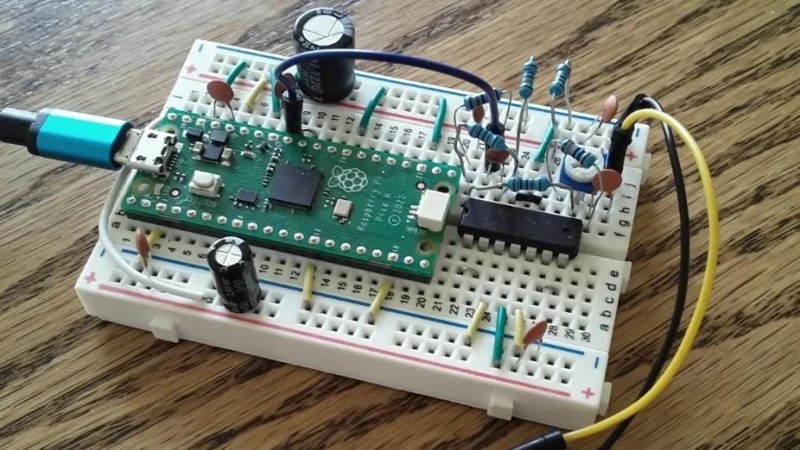USB audio is great, but what if you needed to use it and had no budget? Well, depending on the contents of your parts bin, you might be able to use [Veyniac]’s Pico-Audio-Interface as a free (and libre! It’s GPL3.0) sound capture device.
In the project’s Reddit thread, [Veyniac] describes needing audio input for his homemade synth, but having no budget. Necessity being the mother of invention, rather than beg borrow or steal a device with a working sound card, he hacked together this lovely device. It shows up as a USB Audio Class 2.0 device so should work with just about anything, and offers 12-bit resolution and 4x oversampling to try and deal with USB noise with its 2-channel, 44.1 kHz sample rate.
Aside from the Pico, all you need is an LM324 op-amp IC and a handful of resistors and capacitors — [Veyniac] estimates about $10 to purchase the whole BOM. He claims that the captured audio sounds okay in his use, but can’t guarantee it will be for anyone else, noise being the fickle beast that it is. We figure that sounding “Okay” has got to be pretty good, given that you usually get what you pay for — and again, [Veyniac] did build this in a cave with a box of scraps. Well, except for the cave part. Probably.
While the goal here was not to rival a commercial USB sound card, we have seen projects to do that. We’re quite grateful to [Omadeira] for the tip, because this really is a hack. If you, too, want a share of our undying gratitude (which is still worth its weight in gold, despite fluctuations in the spot price of precious metals), send in a tip of your own.
















I’m not sure what kind of “USB noise” the original poster is talking about. Power noise, perhaps? If that’s it, that would likely be better dealt with by power filtering.
Amusing too that the OP built a whole modular synth, but didn’t have any budget left over for a decent audio interface.
Maybe the RP2024 ADC issue.
USB audio is great, but what if you needed to use it and had no budget?
Amazing introduction…
A usb sound card can be bought for less than $10 though (I’ve seen them as low a $5). It’s usually a mike input but with a bit of hacking I’m sure it’s possible to convert it to a line-in. But it’s of course more fun to make your own.
Yea, but I’ve found that some of those cheapo USB pieces have a nasty sine wave hum in them, to the point that they literally heat up earbuds.
i think it’s a sickness.
(every accusation is a confession)
Good project, especially for someone wanting to understand how A/D conversion is done. And USB, too.
Yeah, USB can be a source of noise for Pico down at the audio frequencies. Those caps are overkill, though. What is needed is a different cable, ferrite bead or both.
Next, the guy guessed right to toggle SMPS into PWM mode. Received 10 dB better noise floor in exchange for different spur positions. The SMPS switches anywhere between 0.8 to 1.2 MHz and drifts with temperature, so its a bit of lottery where it folds. Proper solution would be to jumper 3V3_EN to GND and supply external clean 3V3 from e.g. AMS1117-3.3 linear regulator. That would bring the noise floor down to below 12b for sure.
Finally, 12b ADC of Pico is not 12b but really only good for about 9.5 bits. 4x oversampling gives like 10.5b. Not great, not terrible I guess, since at 1.5 kHz we get extra 2.5b effective bits for grand total of 13b.
the title made me think, “parts bin, which drawer has the 470uf caps and how many are left?”
How can this be UAC 2 when the Pico has only USB 1.1?